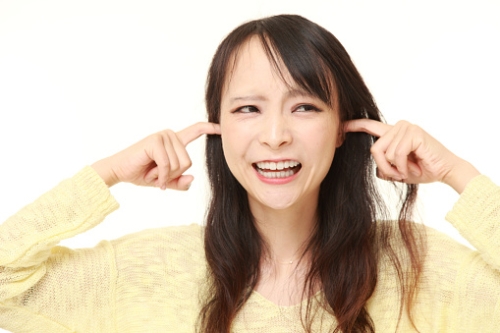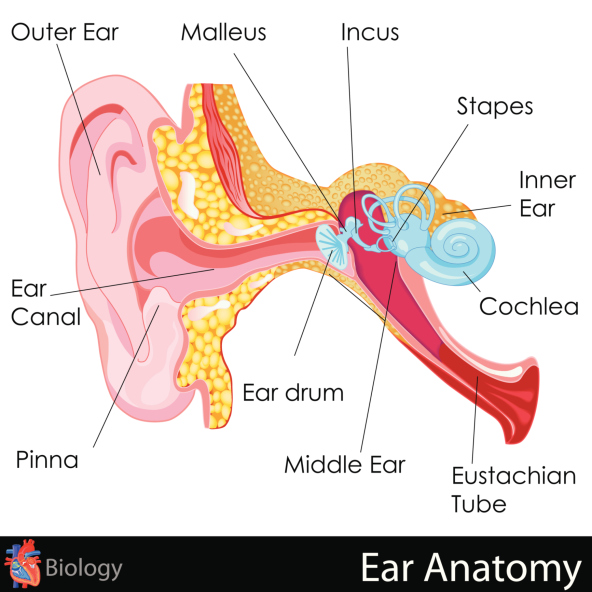 Pressure in the ears, also known as “blocked ears” or “ear popping,” can result from various biological or environmental causes.
Pressure in the ears, also known as “blocked ears” or “ear popping,” can result from various biological or environmental causes.
Being able to relieve the associated pain and pressure, therefore, takes a different approach than the one used, for instance, to relieve ear pressure from the sinus cavities; that is, how you relieve ear pressure from a cold differs from how you relieve ear pressure from flying, and so on.
Before this can be properly explained, a quick anatomy review is in order.
This is your ear:

The part of this diagram you will want to pay attention to is the Eustachian tube in the lower-right corner. The Eustachian tube connects to the nasopharynx and serves as a way to help equalize the air pressure between the middle ear and the outside atmosphere.
Normally, the Eustachian tube stays closed, but it opens in response to pressure differentials and when you do certain things like swallowing. Most causes of persistent ear pressure, and how you relieve ear pressure and pain or relieve ear fullness involve the Eustachian tube to some degree.
In This Article:
What Are the Causes and Symptoms of Ear Pressure?
Although most ear pressure issues involve the Eustachian tube, they each present differently and can come with other associated symptoms. Paying attention to the signals your body is sending can help make recognizing the underlying cause (and solution) easier.
Ear Barotrauma
This is when the Eustachian tube is being physically prevented from opening, usually as a result of high atmospheric pressure or a rapid change in outside air pressure.
This is most often seen when taking off or landing in an airplane (i.e., sudden altitude change) or when diving (i.e., high atmospheric pressure). It can also be caused by driving along mountain roads or engaging in similarly elevated activities. The net result is that when the Eustachian tube is unable to open, air can’t reach the middle ear.
This causes the middle ear to have much lower pressure than the outer ear and causes the eardrum to bulge, resulting in pain and possible additional injuries. Although normally the result of air pressure, barotrauma can also happen if the throat swells up and prevents air from flowing into the Eustachian tube.
Barotrauma usually presents with ear pain, general discomfort or stuffiness, and decreased or muffled hearing. The severity of all of these symptoms depends on the extent of the pressure on the eardrum and how long it has been going on. In severe cases, barotrauma can cause the eardrum to rupture and result in bleeding from the ear or nose.
Ear Congestion
Another duty the Eustachian tube has is to help drain fluid or mucus out of the ear. However, if the tube becomes inflamed from an infection, this task becomes much harder. Trapped fluids build up and place pressure on the eardrum and other surroundings.
Not only does this cause ear pressure, ringing, muffled hearing, and potential balancing difficulties, the trapped fluid can breed bacteria and result in additional infections. It’s possible for ear, throat, or sinus infections to cause ear congestion and the condition is more common in children since their Eustachian tubes are shorter.
Eustachian Tube Dysfunction
This is similar to ear congestion but doesn’t involve fluid buildup in the middle ear. Eustachian tube dysfunction is usually the result of a cold or similar infection. As a result of either a plugged ear or nose or a mucus build up, the Eustachian tube becomes inflamed and swollen.
Since this swelling and mucus buildup can take a few weeks to go away, tube dysfunctions can arise even after the triggering infection is eradicated. Allergies such as hay fever are also known causes. Eustachian tube dysfunction presents mainly with dulled or muffled hearing, a feeling of fullness in the ear, dizziness, ringing or buzzing in the ear, and possible ear pain as the eardrum is tensed and stretched from the pressure.
Obstruction
It’s possible to have a blockage in the ear canal that prevents air from flowing normally. The normal culprits are things like earwax buildup or a bony overgrowth. It’s also possible that something has been inserted into the ear that isn’t supposed to be there.
Children are more likely to both have excessive earwax and to stick solid objects in their ear, but adults aren’t immune either. Those warnings on the Q-tip box exist for a reason.
How to Relieve Ear Pressure Naturally
The good news for those looking into how to relieve ear pressure at home is that there are several methods that can be used to try to force open the Eustachian tubes and restore pressure balance to the ear.
Unfortunately, there are fewer natural solutions for how to relieve pain from an ear infection unless the pain is solely caused by pressure.
If, for example, the pain is from inflammation, you may need to wait it out. Making and self-applying a tincture, herbal or otherwise, is not advisable since it isn’t a good idea to stick anything in your ear without a doctor’s permission. Still, if you need to know how to relieve pressure from an ear infection, many of the following should help.
Yawning or Drinking
Part of how we yawn involves opening the Eustachian tube, so forcing a yawn can help relieve mild barotrauma and possibly help in cases of congestion or dysfunction. Since the Eustachian tube opens when you swallow, eating or drinking anything (or dry swallowing) may also help.
However, gulping water needs special mention. Since mucus will become thin and watery if you drink more fluids, gulping down water can help more in cases of ear congestion or dysfunction.
The water will help thin out any mucus in the ear, the Eustachian tube, or in your sinuses or nose if that’s the source of the pressure problem.
Indulge Your Sweet Tooth
Specifically, suck on a candy or chew gum since both will promote opening of the Eustachian tube repeatedly over the life of the treat. If sweets aren’t your thing, sucking on a mint will work just as well, as would eating anything chewy.
The Valsalva Maneuver
This is a more direct means of forcing the Eustachian tubes open and can be performed pretty much anywhere. The Valsalva maneuver has three basic steps:
1. Take a deep breath and close your mouth.
2. Pinch your nose shut.
3. Try and exhale through your nose.
You should hear a popping sound and feel the pressure change if the Eustachian tubes open. Although useful, the Valsalva maneuver shouldn’t be done for too long since it can hurt the eardrum if you get too persistent. Stop if it starts making your ears hurt.
One-Legged Gravity Hopping
It may sound silly, but this can be surprisingly effective for relieving ear congestion if there are any fluids trapped within the Eustachian tube. Stand on one foot and tilt your head so that the blocked side faces the ground.
Then, hop on one foot as steadily as you can. The motions in conjunction with the angle of your head should help dislodge any fluid that has become trapped. Once you finish, lie down with the congested ear facing down to further drain fluid.
Preventing Ear Pressure
Preventing pressure buildups is possible in certain conditions. Barotrauma is the cause that is most receptive to preventative methods. Many of the methods used to relieve ear pressure, such as sucking on a candy or using the Valsalva maneuver, can be employed pre-emptively if you know you are going to be experiencing a pressure change.
For instance, you can suck on a candy during a plane’s takeoff or landing or when you are driving up or down a mountain. Beyond this, there are some additional measures you can take to reduce your susceptibility to ear pressure and the severity if it occurs:
- Filtered earplugs exist that are designed to manage the pressure change and prevent uncomfortable ear pressure. They can usually be bought at airports or drug stores.
- Being congested from a cold or sinus infection makes barotrauma worse. If possible, avoid flying on an airplane or going scuba diving if you’re already feeling stuffy.
- Don’t stick things in your ear. You might think this doesn’t need to be said, but you would be wrong.
When to See a Doctor
Ear pressure normally goes away on its own and even ear infections normally resolve without medical intervention. However, there are certain conditions that suggest either severe barotrauma or an infection warranting medical attention. If you experience any of the following, schedule an appointment with your doctor:
- Ear pain severe enough to be disruptive
- Bleeding from the ears
- Fever alongside ear pain and pressure
- Hearing loss or muffling that doesn’t go away
- Pressure persists for more than a day
Also Read:
- Tinnitus (Ringing in the Ears): Symptoms, Causes, and Treatments
- Rash Behind the Ear: 5 Causes and Treatments
- 8 Ways to Get Water Out of Your Ear
Sources for Today’s Article:
“Pressure in Ear,” New Health Guide web site; http://www.newhealthguide.org/Pressure-In-Ear.html, last accessed April 14, 2016.
Bentz, B., et al, “Barotrauma,” American Hearing Research Foundation web site, last updated October; 2012; http://american-hearing.org/disorders/barotrauma/, last accessed April 14, 2016.
